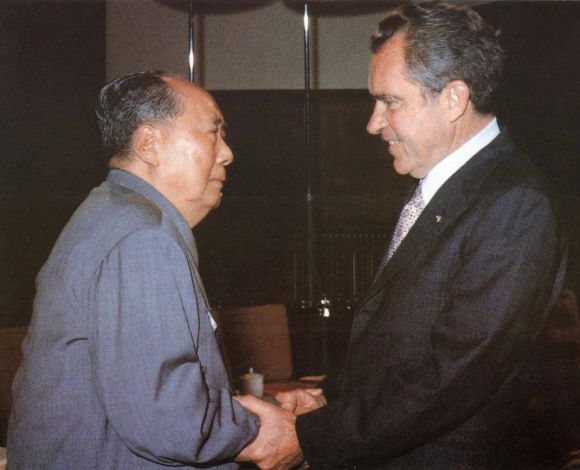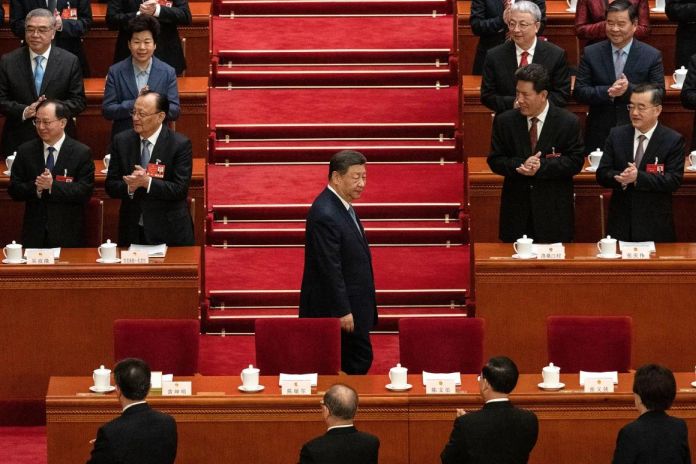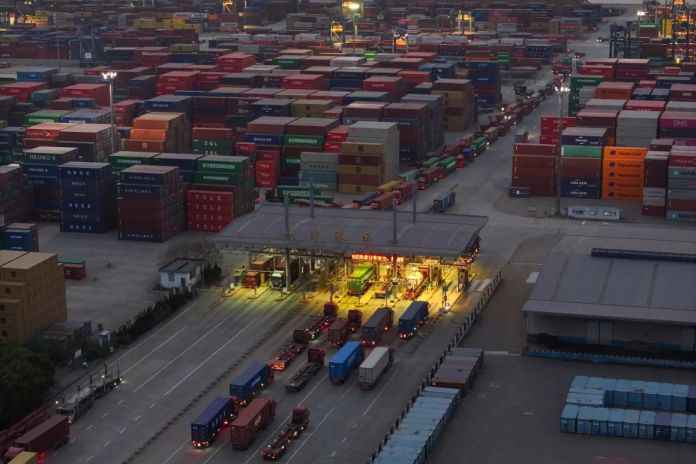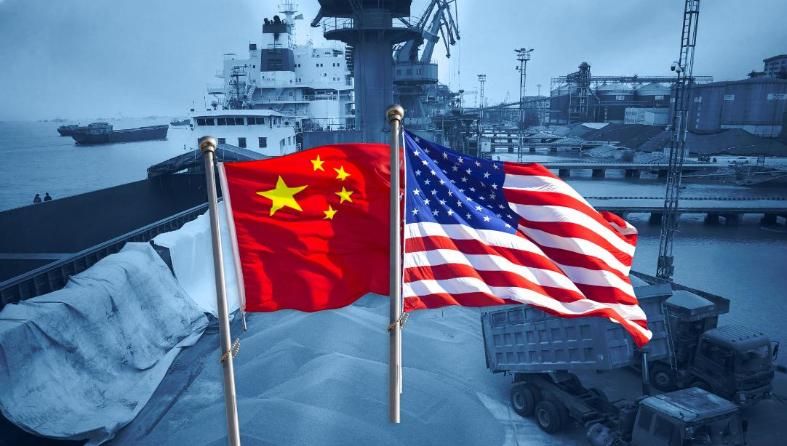By Eric Vandenbroeck and co-workers
US Slams 104% Tariffs on China
President Donald
Trump just ignited a direct showdown with the one nation that might
be able to beat the United States in a trade war.
Trump’s escalation
against China — which is about to face tariffs of at least 104% on goods
entering the US — is the most serious pivot yet in his global tariff onslaught
and has the most potential to inflict severe blowback on American citizens in
soaring prices.
The confrontation
follows years of US attempts to address perceived trade abuses by China. It’s
also the culmination of a decade or more of worsening relations prompted by an
aggressive and nationalistic shift by a Pacific competitor
turned hostile superpower that now seems itching to challenge US might.
And it’s a dark
landmark in a diplomatic relationship that will help define the 21st century
and a breakdown for a long US project to prevent tensions from erupting into a
full-on trade war — or potentially much worse — between two giants.
The US has been
trying to manage China’s emergence for more than 50 years — since President
Richard Nixon’s pioneering visit to Chairman Mao Zedong to “open” an
isolated and impoverished nation and to drive a wedge between its leaders and
their communist brethren in the Soviet Union. It’s been nearly a
quarter-century since another milestone: when the US ushered China into
the World Trade Organization in hopes of promoting democratic change and
locking it into a rules-based, Western-oriented economic system.
The ultimate failure
of those well-intentioned efforts is being laid bare in Trump’s second term.
The president rose to power on a populist wave that was partly a reaction to
globalization that exported US industrial jobs to China and left blight in its wake.

Chinese communist
leader Chairman Mao Zedong welcomes US President Richard Nixon at his house in
Beijing in 1972.
Prospects for a deal with China seem grim
Trump claims that
scores of nations are eager to make trade deals to defray painful US tariffs.
But China isn’t
joining their ranks.
Beijing rebuffed
Trump’s warning not to retaliate against an earlier 34% tariff on top
of a first round of duties — warning that it was ready to fight to “the end.”
The US leader, caught up in a fast-spiraling clash with President Xi Jinping, then
had to preserve his credibility by making good on his threat to impose a
gargantuan import tax on goods from the world’s second-largest economy on
Wednesday.
“Countries like China
who have chosen to retaliate and try to double down on their mistreatment of
American workers are making a mistake,” White House press secretary Karoline
Leavitt said Tuesday. “President Trump has a spine of steel, and he will not break,
and America will not break under his leadership.”
The vast stock of
personal and political capital Trump has now invested in the faceoff with Xi
makes this the most serious lurch of a volatile week since the US president
announced his “Liberation Day” tariffs in the White House Rose Garden.
China is showing
every sign that it thinks it can outlast Trump in their clash, for which it has
been preparing for years. And it’s not clear that Trump and his top officials
are fully prepared for the extent of China’s resilience or the pain it can impose
on American consumers.
If the US president
assumed that what he almost daily hails as his “great relationship” with Xi
would yield a quick Chinese climbdown, he’s wrong. The prospect of a trade
agreement with Beijing similar to the one in the first
Trump term, which largely fell apart during the pandemic, seems distant.

Tensions are peaking over trade with hubris on both
sides
Trump’s claims that
the US has been “raped” and “pillaged” by trade partners are hyperbolic. But
his grievances about Beijing’s behavior have been shared by multiple
presidents. Tensions often flare over import dumping, market access for US
firms, intellectual property theft, currency manipulation, and industrial
espionage. Previous White Houses pursued targeted enforcement and other
penalties to try to reshape China’s behavior. Years of acrimony in the
relationship have fueled the shared bipartisan doctrine in Washington that
Beijing is the preeminent military and economic threat to US power.
But Trump’s
aggression is unparalleled. He believes he has a unique and perhaps final
opportunity to transform the US dynamic with what the US Trade Representative’s
office describes as the world’s largest trading nation. “We have one shot at
this,” Trump told reporters in the Oval Office on Monday.
But his method is
impulsive and indiscriminate; it lacks a clear strategy.
It also shows little
respect for Chinese dignity and power — a recurring theme in the
administration’s dealings with other countries.
Vice President JD
Vance, for instance, mocked China last week in criticizing past US trading
policy. “We borrow money from Chinese peasants to buy the things those Chinese
peasants manufacture,” he said. “That is not a recipe for economic prosperity.
It’s not a recipe for low prices, and it’s not a recipe for good jobs in the
United States of America,” Vance told “Fox & Friends.”
The vice president’s
contemptuous remarks ignored the transformation in China’s economy. It is now a
global leader in innovation on artificial intelligence, electric vehicles,
energy production, and in many other areas. Beijing on Tuesday condemned Vance’s
words as “astonishing,” “lamentable,” “ignorant,” and “disrespectful.”
There are high-stakes
political, global, and economic reasons why Xi can’t bend.
The ruthless Chinese
leader presents himself as a historic catalyst of Chinese civilization’s
rightful return to power and prestige. A capitulation to a tough-talking
American president would, therefore, be unthinkable. Showing weakness to the
United States would also undercut China’s power and would be seen as a loss of
face — especially within Asia.
China’s rhetoric,
meanwhile, is peppered with assumptions that the US is trying to devastate its
economy and political system. Liu Pengyu, spokesman
for China’s embassy in Washington, for instance, condemned US tariffs on
Tuesday as “abuse” and as an infringement of China’s “legitimate rights.”
In Beijing, as in
Washington, hubris is stoking the antagonism.
China’s official
media bristles with certainty that America is an empire in decline. Far from
being a show of strength, Trump’s second presidency and the political chaos he
incites are seen as symptoms of weakness.
Trump’s histrionics
and attacks on US allies, including in Southeast Asia, also play into China’s
argument that the United States is not a reliable partner, and that China’s
brand of capitalism twinned with political control is a better model.
China’s confidence
ahead of what could be a dragged-out trade battle with the United States is
also rooted in Xi’s reorientation and modernization of the Chinese economy.
“I think if you are
Xi Jinping right now, you’re thinking, ‘Well, hey, on the metrics that I care
about — technological resilience and self-reliance, we are doing ok, these
tariffs may not immediately impact us,” said Lily McElwee, adjunct fellow at
the Center for Strategic and International Studies. Xi may also believe that
beyond China’s core strength, it has “retaliatory tools that (it) can impose
that will be costly to the United States as well,” said McElwee, who is also
president and CEO of the Phoenix Committee on Foreign Relations.
As a real
authoritarian leader, Xi, unlike Trump, has no worries about the impact of
a trade war on looming elections — such as the congressional midterms next
year. And while public opinion is still important in China, Xi may reason he
can afford to inflict more pain on the Chinese than Trump can on Americans.
If US inflation soars
and sets off a recession, it may be the Americans who sue for trade peace on
conditions favorable to Beijing.
Trucks arrive at the container terminal in Nanjing in
east China's Jiangsu province on April 8, 2025.

Pain is coming for American consumers.
China has been the
top foreign supplier of goods to the US, accounting for up to 16% of total
imports in recent years, according to the USTR. It dominates the market in
smartphones, computers, and toys — likely to be hit by massive price hikes that
take them out of reach of many Americans when the new tariffs come into force.
Taken together with Biden administration tariffs on China, which expanded on
Trump's first-term duties, China now faces an effective average tariff rate of
125%.
Beijing can also
inflict other penalties on the United States, such as halting export licenses
for rare earth minerals that are vital to the US tech industry — one reason why
Trump may have been so obsessed with finding alternative sources of supply in places
like Ukraine and Greenland.
After seeing the
severe inflationary impact in the US of supply chain crunches during the
pandemic, Chinese leaders could choose to impose new artificial curbs on the
flow of goods to the US. American law and commercial firms might be restricted
from operating in China. And Beijing could jolt the US agricultural heartland
by limiting the import of soy beans and Sorghum. Each
of these steps would hurt Chinese as well as Americans — but they’d demonstrate
Xi’s power of retaliation.

Small businesses are
also vulnerable. While giants like Apple can seek alternative manufacturing
bases — in India, say — US firms that rely on goods and components from China
will be left hugely exposed.
“If you are a small
business, particularly on the import side or the input side, there’s going to
be pain,” said Alex Jacquez, a former special assistant for Economic
Development and Industrial Strategy to President Joe Biden. Broader economic
consequences will follow. “You’re looking at a drag on GDP that is going to be
a drag on the labor market. You are looking at inflationary pressure,” Jacquez
said.
“One of the concerns
here is there is not rational thought or direction to the strategy.”
For updates click hompage here